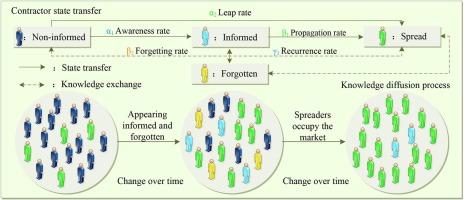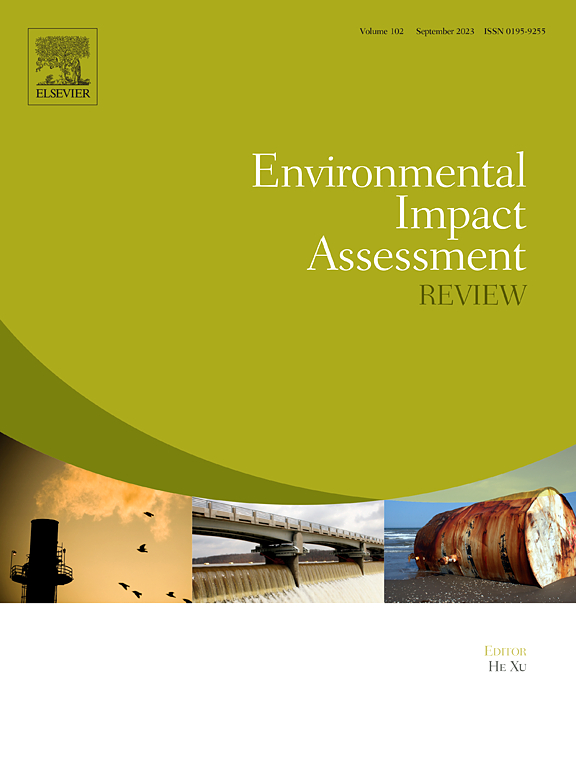可持续的涟漪:揭示承包商的知识-状态转换和基于违反环境制裁的群体共识
IF 11.2
1区 社会学
Q1 ENVIRONMENTAL STUDIES
引用次数: 0
摘要
建筑业的可持续发展要求减少对生态环境的干扰和能源消耗,控制污染,遵守环境法规,避免受到环境制裁。与环境合规相关的绿色知识会从关系网络扩散到整个承包商群体,并通过相互学习和传播填补知识空白,从而促进环境友好行为的实施。本研究考察了不同承包商状态下由环境制裁衍生出的环境违规知识的转移扩散动态和演变过程。通过比较不同因素对传播过程的贡献,找出了缩短承包商达成绿色共识和实现可持续施工时间的关键因素。利用改进的易感-暴露-感染-恢复模型,将承包商描述为非知情者、知情者、传播者和遗忘者,以构建状态转移路径。此外,还利用细胞自动机模型演示了绿色知识在承包商群体中的传播,并分析了状态转移路径、传播者布局和知识可达性邻域如何影响传播效率。模拟结果表明,一旦知识扩散趋于稳定,传播者状态是唯一的剩余状态;此外,情景参数的不同会影响各状态之间的转换率,但不会影响各状态的最终比例。离散分布和传播者的影响与知识扩散效率呈显著正相关,而状态转换路径则影响甚微。这些发现为促进绿色知识在承包商群体中的传播提供了指导,从而在避免环境风险的同时减少环境损害,满足建筑业绿色转型的需求。本文章由计算机程序翻译,如有差异,请以英文原文为准。

Sustainable ripples: Unveiling contractor knowledge-state transitions and group consensus based on environmental sanction violations
Sustainable development in the construction industry requires the reduction of ecological disturbances and energy consumption, control of pollution, and adherence to environmental regulations to avoid environmental sanctions. Green knowledge affiliated with environmental compliance spreads from the relationship network to the whole group of contractors, and knowledge gaps are filled via mutual learning and dissemination to promote the implementation of environmentally friendly behavior. This study examined the transfer-diffusion dynamics and evolution of knowledge on environmental violations derived from environmental sanctions in different contractor states. The contributions of different elements to the diffusion process were compared to identify the key factors that reduce the time until contractors reach a green consensus and achieve sustainable construction. Using an improved susceptible–exposed–infectious–recovered model, contractors were characterized as non-informed, informed, spreaders, and forgetters to construct state-transfer paths. In addition, a cellular automaton model was used to demonstrate the diffusion of green knowledge in contractor groups and analyze how state-transfer paths, spreader layouts, and knowledge-reachability neighborhoods affect the diffusion efficiency. Simulations indicated that once knowledge diffusion stabilized, the spreader state was the only remaining state; moreover, differences in the scenario parameters affected the transition rates between each state but not the final proportions of the states. Discrete distribution and spreader influence were positively and significantly correlated to knowledge-diffusion efficiency, whereas the state-transition path had little influence. These findings provide guidance for facilitating the diffusion of green knowledge in the contractor community to reduce environmental damage while avoiding environmental risks to meet the green transformation needs of the construction industry.
求助全文
通过发布文献求助,成功后即可免费获取论文全文。
去求助
来源期刊

Environmental Impact Assessment Review
ENVIRONMENTAL STUDIES-
CiteScore
12.60
自引率
10.10%
发文量
200
审稿时长
33 days
期刊介绍:
Environmental Impact Assessment Review is an interdisciplinary journal that serves a global audience of practitioners, policymakers, and academics involved in assessing the environmental impact of policies, projects, processes, and products. The journal focuses on innovative theory and practice in environmental impact assessment (EIA). Papers are expected to present innovative ideas, be topical, and coherent. The journal emphasizes concepts, methods, techniques, approaches, and systems related to EIA theory and practice.
 求助内容:
求助内容: 应助结果提醒方式:
应助结果提醒方式:


